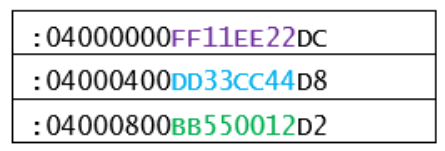Consider the following Intel HEX memory file.
Figure 1. Memory File Data - Intel HEX
Memory File

The binary stream of bits for above memory file data is:

If the memory port width is 9 bits, you must pad 7 zeros to every 9 bits of data from the
binary stream to create 16 bits (byte-aligned), as shown in the following figure.

Figure 2. Padding Zeros to Create 16
Bits

The following figure shows the equivalent memory file data padded with zeros to achieve a 9-bit write port width.
Figure 3. Equivalent Memory File Data Padded with Zeros (9-bit Write Port Width)

When the tool parses the above memory file data (padded with zeros), the tool converts the data to binary and reads it as a stream of bits. If the port width is 9 bits, the tool reads 16 bits (byte-aligned), ignores the upper 7 bits, and stores the lower 9 bits of actual data in RAM, as shown in the following table.
| Address | Data |
|---|---|
| 0 | 0x1FF |
| 1 | 0x108 |
| 2 | 0x0BB |
| 3 | 0x1A4 |
| 4 | 0x13D |
| 5 | 0x061 |
| 6 | 0x113 |
| 7 | 0x176 |
| 8 | 0x055 |
| 9 | 0x100 |
| A | 0x004 |
| B | 0x000 |